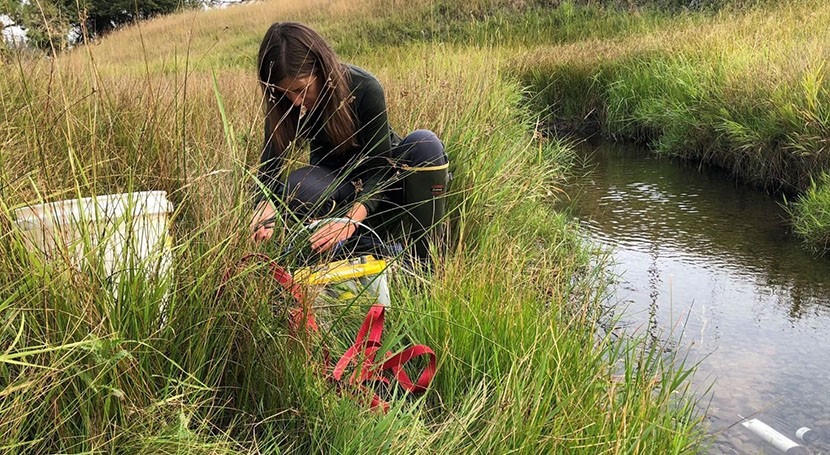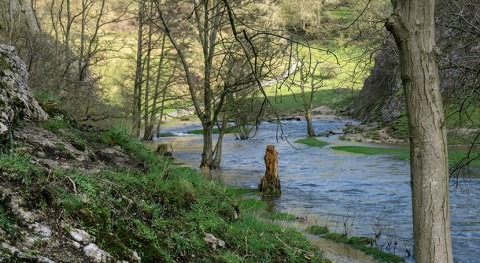New research led by University of Nevada, Reno Assistant Professor Joanna Blaszczak shows hypoxia in rivers and streams is generally much more prevalent across the globe than previously thought. Hypoxia is low or depleted oxygen levels in surface waters that can be harmful to aquatic species and can in some cases increase production of harmful greenhouse gases from rivers.
The research, published recently in the journal Limnology and Oceanography Letters, compiles over 118 million readings of dissolved oxygen and temperature taken from over 125,000 locations in rivers across six continents and 93 countries and spanning over 100 years, from 1900 to 2018. Hypoxia, defined in this study as dissolved oxygen concentrations below 2 milligrams per liter, was detected in rivers and streams in 53 countries, with 12.6% of all locations exhibiting at least one hypoxic measurement.
“Hypoxia in coastal waters and lakes is widely recognized as a detrimental environmental issue, yet we have lacked a comparable understanding of hypoxia in rivers,” Blaszczak, with the University’s College of Agriculture, Biotechnology & Natural Resources, said. “While 12.6% might not seem like a huge percentage, previously it was generally thought that occurrences of hypoxia in rivers and streams were exceedingly rare. Having shown presence of hypoxia in one of every eight river locations with data is definitely a game changer in terms of how we need to think of and give attention to the issue of hypoxia in rivers and streams.”
Blaszczak says that advances in measuring hypoxia over the past 15 years or so using field-deployable dissolved oxygen sensor technology that allows for constant monitoring, such as every hour, has given researchers the tools to get a better handle on the presence of hypoxia. Previously, readings were taken manually using a handheld probe or by collecting water samples mostly during the day, when oxygen levels are naturally higher, due to photosynthesis occurring during daylight hours.
Hypoxia was detected in rivers and streams in 53 countries, with 12.6% of all locations exhibiting at least one hypoxic measurement
“Photosynthesis by algae produces oxygen that is released into the water column,” Blaszczak explains. “So, you’re not getting a true picture of hypoxia occurrence if you only measure during the day. Hypoxic conditions are much more likely to develop in the early morning hours, after the lack of photosynthesis all night. The newer technology allows for us to capture that data.”
In fact, the research showed a dramatic difference in results between using the older methods and the newer technology, due to the times of day measurements are taken.
“We find that if we only sampled during the day every day, between 8 a.m. and 5 p.m., it would under detect the number of river locations where we observe hypoxia by about 25%,” she said.
Blaszczak says that much of the data from the study is more recent, and taken using the newer technology.
“There wasn’t a lot of testing going on, especially before the 1950s,” she said. “Even all the way up to around 2005 or so, the data at a global scale is pretty scarce.”
Research shows natural and human influences
As expected, the data showed hypoxia in rivers was most present in warmer, smaller and lower-gradient, stiller waters, where oxygen isn’t being “stirred” into the water from turbulence. Blaszczak says the research found these conditions occur most often in rivers draining naturally occurring wetlands, as well as in rivers draining some urban areas, where human actions have created hypoxic conditions.
“We as people managing waters often influence these conditions – by extracting water, building dams and increasing the amount of organic matter released into rivers, for example,” she says. “We can set up these conditions of very low flows. Rivers surrounded by wetlands and urban areas had about the same probability of hypoxia occurrence. That shows that while it can occur naturally, we also can create these conditions that are conducive to hypoxia.”
Blaszczak says that hypoxia often isn’t recognized until it’s too late.
“You’ll see a report in the media of a fish kill that was caused by hypoxia – from very low flows from dams, a release of something into a river, or something else we can control,” she says. “If we can put out more sensors to monitor conditions, we can get early warning signals, and take action to mediate the problem, such as modifying the flow in some way.”
Blaszczak says newer sensor technology that provides constant monitoring is also important because the duration of hypoxic conditions affects the harm it might induce.
“Fish do have, in some cases, avoidance strategies. So, if it is only for a couple of hours, they can try to manage themselves, by staying up closer to the surface, for example,” she says. “But if it is more extended, then they have a harder time. And, there are other factors. The size of the organism may influence its ability to survive, and some organisms are not as mobile, so they can’t adjust to survive a more prolonged hypoxic event.”
Besides the harm hypoxia can cause to aquatic life, it can also stimulate production of the greenhouse gases methane and nitrous oxide.
“There’s just nothing good about hypoxia in rivers or other bodies of water,” Blaszczak says. “We can’t eliminate it completely, but we can certainly do a better job of monitoring it and take actions to prevent it, rather than to stimulate it.”
Taking a global view
On a more positive note, Blaszczak says that looking at data from 1950 to 2018, the research showed that, globally, there doesn’t seem to be an overall increase in hypoxic conditions in rivers. However, in certain locations, there are increases. And, in some locations, the presence is extreme, she says. The researchers put together a worldwide map that is featured in the research article, which color codes the number of hypoxia occurrences they found by region, with blue being rare occurrences and red being the highest presence of hypoxia.
“You’ll see that Florida is completely red, off the charts,” Blaszczak noted.
The research showed that, globally, there doesn’t seem to be an overall increase in hypoxic conditions in rivers
Much of the U.S. is in the yellow, or midrange. Blaszczak says that there is much more data available from the U.S. overall than other countries. She and a team of researchers compiled data from government-supported work and other published data to create the data set that spans all continents except Antarctica, but is dominated by data from North America. Each location had to have a geographic coordinate, at least one measurement of dissolved oxygen, a corresponding water temperature and a date-time stamp. Blaszczak then analyzed the data, as part of her research for her College’s Department of Natural Resources & Environmental Science and Experiment Station.
She embarked on leading the study after attending a workshop in September 2018 held in Switzerland and convened by Jim Heffernan and Tom Battin from Duke University. The workshop aimed to advance the global understanding of the dynamics of hypoxia in rivers and streams and was supported by the Swiss National Science Foundation and the U.S. National Science Foundation.
Moving forward, Blaszczak says more monitoring with newer technology is key to mitigating harmful effects of hypoxia in rivers.
“We need to further develop our capacity to identify when and where rivers are vulnerable to the development of hypoxic conditions, so that we can guide river management in the face of continuing climate and land-use change. Supporting ongoing monitoring and expanding monitoring to regions where data is sparse is essential,” she said.




